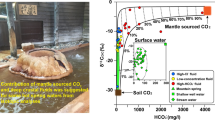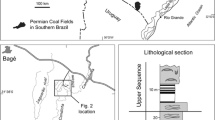Abstract
The Edwards Aquifer in south central Texas (USA) features a distinct fault line defining the freshwater and saline water zones. We aim to elucidate the evolutionary behavior of carbon and sulfur emanating from deep environments and flowing in surficial environment so as to better understand the cycling of these metals in water environments. To characterize the evolution of carbon and sulfur species in surficial environment as the fluid emanates from a deep saline aquifer, we monitored the chemical and isotopic (δ13CDIC and δ34SSO4) parameters over a 700-m stretch on a stream-pond system situated on the saline-freshwater line of the Edwards Aquifer’s artesian zone. A three-tier evolution process associated with the interaction of a deep saline fluid with a fresh-ponded water was observed, namely: A deep fluid control zone characterized by decreasing pH values and relatively high total dissolved solids (TDS) concentrations along the stream path; a mixing zone of the deep fluid and fresh-ponded water where the TDS concentrations showed a sharp decline and a continual decrease in pH values; and a fresh-ponded water-controlled zone with a stable pH value and low TDS concentrations. The decreasing pH values were a result of CO2 outgassing due to the relatively high CO2 partial pressures (10–2.53 atm) relative to atmospheric (10–3.50 atm) in the aqueous system, and the high TDS concentrations were attributed to the deep saline fluid emanating at the well-head. The enrichment in the δ13CDIC and δ34SSO4 for the initial stream path reflects the kinetic isotopic fractionations associated with CO2 outgassing and with the microbial conversion. The zonation of the evolutionary process indicates that (i) solutes play a critical role in the evolution of carbon and sulfur in surficial environment, (ii) kinetic and chemical fractionation are the dominant processes controlling carbon evolution, and (iii) microbial metabolism primarily controls sulfate fractionation and evolution through the conversion of sulfate to thiosulfate.














Similar content being viewed by others
References
Abongwa, P. T., & Atekwana, E. A. (2013). Assessing the temporal evolution of dissolved inorganic carbon in waters exposed to atmospheric CO2(g): A laboratory approach. Journal of Hydrology, 505, 250–265.
Abongwa, P. T., & Atekwana, E. A. (2015). Controls on the chemical and isotopic composition of carbonate springs during evolution to saturation with respect to calcite. Chemical Geology, 404, 136–149.
Abongwa, P. T., Atekwana, E. A., & Puckette, J. (2016). Dissolved inorganic carbon and stable carbon isotopic evolution of neutral mine drainage interacting with atmospheric CO2(g). Science of the Total Environment, 545, 57–66.
Atekwana, E. A., Molwalefhe, L., Kgaodi, O., & Cruse, A. M. (2016). Effect of evapotranspiration on 569 dissolved inorganic carbon and stable carbon isotopic evolution in rivers in semi-arid climates: The 570 Okavango Delta in North West Botswana. Journal of Hydrology: Regional Studies, 7, 1–13.
Budd, D. A., & Vacher, H. L. (2004). Matrix permeability of the confined Floridan aquifer, Florida, USA. Hydrogeology Journal, 12, 531–549.
Canfield, D. E., & DesMarais, D. J. (1991). Aerobic sulfate reduction in microbial mats. Science, 251, 1471–1473.
Chaudhuri, S., & Ale, S. (2014). Temporal evolution of depth-stratified groundwater salinity in municipal wells in the major aquifers in Texas, USA. Science of the Total Environment, 472, 370–380.
Cohen, Y. (1989). Photosynthesis in cyanobacterial mats and its relation to the sulfur cycle: A model for microbial sulfur interactions. In Y. Cohen & E. Rosenberg (Eds.), Microbial mats: Physiological ecology of benthic microbial communities (pp. 22–36). American Society of Microbiology.
Dandurand, J. L., Gout, R., Hoefs, J., Menschel, G., Schott, J., & Usdowski, E. (1982). Kinetically-controlled variations of major components and carbon isotopes in a calcite-precipitating spring. Chemical Geology, 36, 299–315.
Doctor, H. D., Kendall, C., Sebestyen, S. D., Shanley, T. B., Ohte, N., & Boyer, E. N. (2008). Carbon isotope fractionation of dissolved inorganic carbon (DIC) due to outgassing of carbon dioxide from a headwater stream. Hydrological Processes, 22, 2410–2423.
Drever, J. I. (1997). The geochemistry of natural waters: Surface and groundwater environments. Prentice Hall 436 pp.
Farquhar, G. D., Ehleringer, J. R., & Hubick, K. T. (1989). Carbon isotope discrimination and 614 photosynthesis. Annual Review of Plant Biology, 40, 503–537.
Fukui, M., & Takii, S. (1990). Survival of sulfate-reducing bacteria in oxic surface sediment of a seawater lake. FEMS Microbiology Ecology, 73, 317–322.
Groschen, G. E., & Buszka, P. M. (1997). Hydrogeologic framework and geochemistry of the Edwards Aquifer saline-water zone, South-Central Texas. U.S. Geological Survey: Water-Resources Investigations Report 97–4133.
Hardy, J. A., & Hamilton, W. A. (1981). The oxygen tolerance of sulphate reducing bacteria isolated from North Sea waters. Current Microbiology, 6, 259–262.
Hedley, P., Dogramaci, S., & Dodson, W. (2009). The use of major ion analysis and stable isotopes O18 and H2 to distinguish groundwater flow in Karijini National Park, Western Australia.
Jackson, L., & Polk, J. S. (2020). Seasonal delta C-13(DIC) sourcing and geochemical flux in telogenetic epikarst of south-Central Kentucky. Earth Surface Processes and Landforms, 45, 785–799.
Langmuir, D. (1997). Aqueous environmental geochemistry. Prentice-Hall 600 pp.
Larkin, T. J., & Bomar, G. W. (1983). Climatic atlas of Texas. Texas Department of Water Resources (p. 151). Limited Printing Report LP–192.
Longman, M., & Mench, P. A. (1978). Diagenesis of cretaceous limestones in the Edwards aquifer system of south-Central Texas: A scanning electron microscope study. Sedimentary Geology, 21, 241–276.
Maclay, R. W., & Small, T. A. (1983). Hydrostratigraphic subdivisions and fault barriers of the Edwards aquifer, south-Central Texas, USA. Journal of Hydrology, 61, 127–146.
Mills, A., & Urey, H. C. (1940). The kinetics of isotope exchange between carbon dioxide, bicarbonate ion, carbonate ion, and water. Journal of American Chemical Society, 62, 1019–1026.
Morse, J. W., & Mackenzie, F. T. (1990). Geochemistry of sedimentary carbonate. Elsevier.
Musgrove, M., Stern, L. A., & Banner, J. L. (2010). Springwater geochemistry at Honey Creek State natural area, central Texas: Implications for surface water and groundwater interaction in a karst aquifer. Journal of Hydrology, 388, 144–156.
Musgrove, M., Katz, B. G., Fahlquist, L. S., Crandall, C. A., & Lindgren, R. J. (2014). Factors affecting public-supply well vulnerability in two karst aquifers. Groundwater, 52, 63–75.
Musgrove, M., Solder, J. E., Opsahl, S. P., & Wilson, J. T. (2019). Timescales of water-quality change in a karst aquifer, south-Central Texas. Journal of Hydrology X, 4, 100041.
Oetting, G. C., Banner, J. L., & Sharp Jr., J. M. (1996). Regional controls on the geochemical evolution of saline groundwater in the Edwards aquifer, Central Texas. Journal of Hydrology, 181, 251–283.
Opsahl, S. P., Musgrove, M., Mahler, B., & Lambert, R. B. (2018). Water-quality observations of the San Antonio segment of the Edwards aquifer, Texas, with an emphasis on processes influencing nutrient and pesticide geochemistry and factors affecting aquifer vulnerability, 2010-16 (no. 2018–5060). US Geological Survey.
Parkhurst, D. L., & Appelo, C. A. J. (1999). User’s guide to PHREEQC (Version 2.1)-a computer program for speciation, batch-reactions, one-dimensional transport and inverse geochemical calculations. U.S. Geological Survey, Water Resource Investigation Report, 99–4256.
Pentecost, A. (1995). Geochemistry of carbon dioxide in six travertine-depositing waters in Italy. Journal of Hydrology, 167, 263–278.
Postgate, J. R. (1979). The sulphate-reducing bacteria (p. 17). Cambridge University Press.
Rech, J. A., Quade, J., & Hart, W. S. (2003). Isotopic evidence for the source of Ca and S in soil gypsum, anhydrite and calcite in the Atacama Desert, Chile. Geochimica et Cosmochimica Acta, 67, 575–586.
Rees, C. E., Jenkins, W. J., & Monster, J. (1978). The sulphur isotopic composition of ocean watersulphate. Geochimica et Cosmochimica Acta, 42, 377–381.
Sharp Jr., J. M. (1990). Stratigraphic, geomorphic and structural controls of the Edwards Aquifer, TX, USA. In E. S. Simpson & J. M. Sharp Jr. (Eds.), International Association of Hydrogeologists, selected papers for the 28th International Geological Congress, Vol. 1 (pp. 67–82). Heise Hannover.
Suarez, D. L. (1983). Calcite supersaturation and precipitation kinetics in the lower Colorado River, all American canal and east highline canal. Water Resource Research, 19, 653–661.
U.S. Environmental Protection Agency. (1994). Method 200.7: Determination of metals and trace elements in water and wastes by inductively coupled plasma-atomic emission spectrometry. Revision 4.4. Cincinnati, OH, U.S.A..
United States Environmental Protection Agency. (2002). Delineation of source-water protection areas in karst aquifers of the ridge and valley and Appalachian plateaus physiographic provinces: Rules of thumb for estimating the capture zones of springs and wells. EPA 816-r-02-015. Washington D.C., U.S.A..
Usdowski, E., & Hoefs, J. (1990). Kinetic 13C/12C and 18O/16O effects upon dissolution and outgassing of CO2 in the system CO2-H2O. Chemical Geology, 80, 109–118.
Usdowski, E., Hoefs, J., & Menschel, G. (1979). Relationship between 13C and 18O fractionation and changes in major element composition in recent calcite-depositing spring- A model of chemical variations with inorganic CaCO3 precipitation. Earth and Planetary Science Letters, 42, 267–276.
Walker, C. D., & Richardson, S. B. (1991). The use of stable isotopes of water in characterizing the source 717 of water in vegetation. Chemical Geology, 94, 145–158.
Zhang, Y., & Dawe, R. A. (2000). Influence of Mg2+ on the kinetics of calcite precipitation and calcite crystal morphology. Chemical Geology, 163, 129–138.
Acknowledgements
We thank Samantha Gonzales and Karla Tapia for assisting in the sample collection and analyses. We also thank Dr. Shray Saxena for running the anions sample.
Funding
This research was supported financially by the Texas A&M University-San Antonio, Research Council Grants 2018/2019 and 2019/2020, and the Texas A&M University-San Antonio, College of Arts and Science Summer Grants 2019 and 2020.
Author information
Authors and Affiliations
Corresponding author
Additional information
Publisher’s Note
Springer Nature remains neutral with regard to jurisdictional claims in published maps and institutional affiliations.
Highlights
• We assessed carbon and sulfur evolution from deep fluids in surficial environments.
• TDS increases over distance until interaction with fresh surface water, while pH decreases throughout.
• Carbon evolved by CO2 outgassing, whereas sulfur evolved by microbial metabolism.
• Kinetic fractionation was associated with carbon evolution and conversion of sulfate to thiosulfate causes sulfur fractionation.
• Three tier-evolution was established: Zone 1, deep fluid control; Zone 2, mixing area; and Zone 3, freshwater dominance.
Rights and permissions
About this article
Cite this article
Abongwa, P.T., Den, W. Evolution of a Deep Fluid in a Surficial Environment Using Stable Carbon and Sulfur Isotopes: Case of the Transitional Zone of the Edwards Aquifer in South Central Texas. Water Air Soil Pollut 232, 213 (2021). https://doi.org/10.1007/s11270-021-05159-3
Received:
Accepted:
Published:
DOI: https://doi.org/10.1007/s11270-021-05159-3




